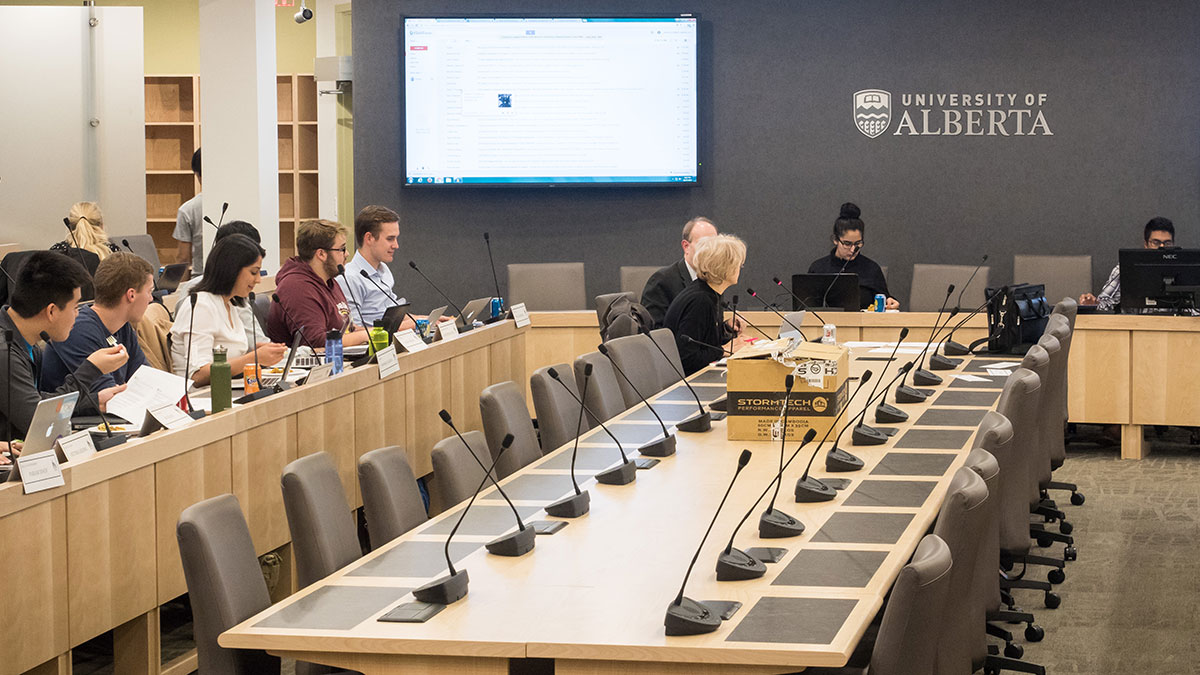 Ab Sch
Ab SchThe University of Alberta operates on a governance model that is aspirational, complex, democratic, and — after having gone through it firsthand — largely fictional.
According to the university’s website, their model of governance promises to “conduct […] affairs effectively, respect jurisdictional borders, capitalize on shared interests, [and] balance and share authority within a civil and productive relationship to serve the greater good.” It’s a bold and noble statement that is marketed as an accurate portrayal of governance, but is not the reality of some committees. I spent last year as the SU’s Vice-President (Operations and Finance) navigating the system, and found a number of instances of upsetting and shady conduct of some members of the administration to advance their agendas at the expense of student voice.
Most students at the university do not understand how our university’s governance model works; it’s too complicated, too slow, and the administration has little interest in clarifying how governance impacts students. The University Governance office has produced a handy presentation for people interested in governance, but to this date I’ve only used it to drift off to sleep. The presentation goes through how the university gets its authority from the Post-Secondary Learning Act (I’m already bored), lots of charts and graphs and dotted lines (I’m checking Snapchat now), policies (dear God), and finally gets to the actual mandates and roles of different committees on campus about halfway through the slides (and now I’m asleep, having fever dreams about terms of reference and points of parliamentary procedure).
This is the reality of decision-making at the University of Alberta — cold and formal, with a hint of dictatorial rule. Having heard from past generations of Students’ Union executives (and having attended some committee and admin meetings myself), I can confidently say that decision-making at the university is very different than what it claims to be on paper. From the meetings I attended, it felt like the majority of motions on the agenda had been decided before students walked into the room, with little chance of convincing any staff members there to give it a second look. Despite there being over 37,000 undergraduate and graduate students on campus, students usually make up only 10 to 40 per cent of any given committee structure, and student representatives are often the only student in a meeting. University administration is not unaware of this imbalance, and can often actually capitalize on it.
A former Students’ Union executive was once asked in an advisory meeting on student affairs to sign off on a proposal they had seen for the first time in that same meeting. They were ambushed with dubious results of a survey conducted by a department and then berated for 45 minutes on why the administration was right and we — students who had collected testimonials and actual stories from living, breathing students — were wrong. When the executive in question refused to sign a letter of support for the department’s proposal (because unlike Terms of Service agreements, we’d want to read something the university gives us before putting a pen to it), the staff got upset, and claimed that we were not acting in the best interest of students.
Some University of Alberta staff — generally, upper management in student affairs departments, who the SU usually interacts with — have intimidated students into agreeing with them, which is antithetical to the entire point of a free-thinking higher education institution. Don’t get me wrong: I love this institution and what it stands for, and have had many wonderful years here, but the reality is that some staff in the administration that set the direction for the university will use governance’s vagueness to their advantage. When students don’t care about the process, staff at the university have the opportunity to push through their agenda without complaint, which often works in their favour. Another past executive was told, after she had voted against a motion, that “a unanimous vote really would look better for the records.” What’s the point of even voting if the staff responsible for a proposal already decided the outcome?
I was planning on bringing a proposal to the governance system on changing gendered pronouns in the Code of Student Behaviour to being neutral. This would have been a directive handed down from GFC Executive Council to make gender neutrality a reality in all documents that it was responsible for, including the Code of Student Behaviour. Rather than do the same thing at 20 different meetings, I would see how administrators like Provost Steve Dew would use this perfectly acceptable process to make governance more efficient, and send it to the Campus Law Review Committee (CLRC) for direct approval rather than do it over and over again at every committee that reported to the CLRC. I wasn’t on this committee, but the VP Student Life is every year, so I asked her to sponsor it, because that’s the process. Those in the highest echelons of the administration seemed as though they didn’t like that the proposal wasn’t coming from their office, so they took it off the agenda. They’re actually not allowed to do this, as the VP was a full voting member of the committee, but they did it anyway, because members of the committee who know it’s against procedure have a hard time drumming up support to reverse the decision; it’s unlikely that students would get riled up over a violation of process.
I got pulled into two condescending meetings with staff from the Dean of Students and University Governance offices where my solidly researched proposal was torn apart and I was told that I should have consulted with the 18 faculties before trying to do something like this. Changing pronouns isn’t even a substantial change. It’s symbolic and important (especially because the Faculty of Law, in 2015, still used only “he” pronouns when referring to all students), but it doesn’t change how the Code is enforced. Also, the Peter Lougheed Leadership College was created with little consultation and ran for a full year before getting formal approval from General Faculties Council; the university got to institute a multi-million-dollar project without due process.
This is dangerous to students and to democracy. University of Alberta leadership could one day decide to implement something truly damaging for students, and there would be no obstacles for them; the provincial government is still finding its sea legs, and we aren’t listened to on governance and advisory committees anyway. Governance can be exciting: anyone on the committee should be able to submit a proposal, collect feedback at a meeting, refine it and consult widely, and bring it back the next month for approval. The university appears to have done their best to make it as dull as possible so students are lulled into not caring, which removes the checks and balances necessary for such an independent institution.
There is hope though. Bodies like the University Senate and some faculty councils are genuinely listening to concerns and using projects and engagement to help fight this structured apathy. And students should fight back too! Demand respect in your meetings, don’t back down when the administration breaks protocol, model a constructive and collaborative meeting structure, and speak up about unfair practices. We need to care about governance by using our voices, because there can be consequences for all of us if we don’t.





Hi Cody, We haven’t met, but I would love to have a chat with you. I’m not sure if you’ve heard about anything that’s been going on at the University of Lethbridge, but I think we’ve had similar experiences. In fact, I have currently fallen down a rabbit hole you may find interesting. Would you be willing to having a chat with me? (I’ll attempt to contact you via FB as well in case you don’t get this comment.)
Is there anywhere that I can go to learn how university governance actually works?
This is the presentation I referenced, but it’s not very clear or explanatory, even to elected students :/ https://www.governance.ualberta.ca/en/LearnAboutGovernance/~/media/Governance/Documents/GO11/GOV/ED/GOV-101-Sept-2016.pdf
This week is actually governance week! Kind of a how-to about governance at the u of a with lots of different sessions from students groups, the su, etc.
Here’s the website: https://www.su.ualberta.ca/governance/gov_week/
And the schedule link: https://www.su.ualberta.ca/media/uploads/983/GovWeek_Schedule_2016_09.pdf
I’m currently deciding which sessions interest me but the Don Iverson one at the end seems like it is going to be good because its the mayor 😛
I’d be interested to see your “well researched proposal” that was torn apart, to see if it was at all justified.
The proposal was to insert gender-neutral language in the governance documents. It’s 2016. Little research and consultation should be required because it’s a no-brainer.
“it’s 2016” is the worst argument you can make. Try again.
OK. Pretend I didn’t write that sentence. You got anything better to say?
It was crafted using SU property/email accounts so unfortunately I can no longer access it. It was ~18 pages and covered two dozen consultations across departments, and referenced other institutions that had made the move (University of Toronto, UBC, Harvard) and government legislation that would have urged the U of A to comply with it. I will ask the SU to release it if there’s interest.
There is interest!